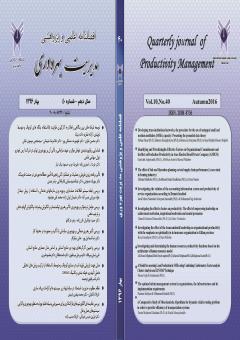بررسی تأثیر رهبری متعالی بر بهرهوری سازمانی با تأکید بر معنویت در محیط کار
محورهای موضوعی : مدیریت بازرگانیرضا اسماعیل پور 1 , هانی نیکوکار 2
1 - دانشیار گروه مدیریت، دانشگاه گیلان، دانشکده ی ادبیات و علوم انسانی،
2 - سرباز نیروی انتظامی
کلید واژه: معنویت در محیط کار, بهرهوری سازمانی, رهبری متعالی,
چکیده مقاله :
بهرهوری یعنی استفاده از منابع و امکانات سازمان برای دستیابی به هدف با کمترین مصرف مواد اولیه. در محیط پرتلاطم و متغیر امروزی چیزی که میتواند سازمانها را نسبت به سایر سازمانها در شرایط مطلوبتری نگه دارد، توجه به بهرهوری در سازمان است و با توجه به اینکه یکی از عوامل مهمی که میتواند سبب بهرهوری کار شود، انگیزش کارکنان برای انجام کار با کیفیت عالی و کمیت زیاد است باید به عواملی که سبب ایجاد انگیزه در افراد برای انجام دادن کار بهتر میشود توجه کرد. رهبری متعالی و معنویت در محیط کار از اصلیترین متغیرهای جهان حاضر هستند که میتوانند انگیزش کارکنان را برای کار با کیفیت و کمیت عالی برانگیزانند و در نهایت به بهرهوری سازمان منجر گردد. این تحقیق از نظر ماهیت از نوع تحقیقات توصیفی- علّی و از نظر هدف کاربردی است. دادهها از طریق پرسشنامه جمعآوری شد و نمونه آماری تحقیق شامل 189 کارمند در سازمانهای بیمه استان گیلان می باشد. دادهها از طریق همبستگی پیرسون و مدلیابی معادلات ساختاری با استفاده از نرم افراز SPSS 20 و LISREL 8.8 مورد تجزیهوتحلیل قرار گرفت. نتایج حاصل نشان داد که رهبری متعالی دارای اثر مثبت و معنیدار روی معنویت در محیط کار و بهرهوری سازمانی است؛ همچنین معنویت در محیط کار دارای اثر مثبت و معنیدار روی بهرهوری سازمانی است.
Productivity means using the resources and possibilities oforganization in order to get hold of the goal with least materialexpenditure. In the changeful and turbulent world of today, productivityis one of important factors which can make difference among the rivalorganizations. Motivating the employees to do the job with the highestquality and quantity increases the productivity. Transcendentalleadership and spirituality in the workplace is one of the mostchallenging factors in today's world. The research method was an applieddescriptive casual. To gather the data a questionnaire was used. Thestatistical population was 372 employees. Using Cochran formula thesample size was 189 employees. To analyze the data Pearson correlationand structure equation modeling were used. Spss 20 and lisrel 8.8.wereused Results showed that transcendental leadership having meaningfuland positive effect on the Spirituality in the Workplace andorganizational productivity. Also Result showed that Spirituality in theWorkplace having meaningful and positive effect on the organizationalproductivity.


